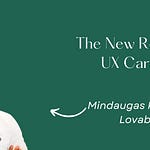Listen now on Apple, Spotify, and YouTube.
—
Mark Cox is a lead researcher and the Design Research and Service Design Agency Spotless in London. He’s been in research for about 7 years, and because he’s operated in an agency, he’s been lucky enough to work on all kinds of projects in different industries. The hat he currently wears is as a Games User Researcher.
In our conversation, we discuss:
The early origins of games UXR and how it still leans on its Atari-era roots.
Why you can’t apply traditional UX timelines and methods to game development.
What “positive friction” means and when player frustration is part of the design.
How Mark tests narrative and art concepts with non-interactive prototypes.
Where aspiring games UXRs should actually start if they want to break in.
Some takeaways:
Unlike traditional UX, games research isn’t focused on removing friction, it’s about shaping it. Some frustration is intentional, and part of the fun. Mark works with teams to understand when challenge adds value and when it tips into player drop-off. This means the researcher’s job is to trace the emotional arc of gameplay, not just catch bugs or confusion.
Narrative and concept testing often happens with no prototype in sight. Mark tests scripts, art, and design direction using static slides, paper wireframes, or storyboards. Focus groups are a big part of this phase, helping teams hear how players talk about characters and world-building. If the story isn’t landing early on, it rarely gets better by launch.
Mark outlined multiple types of playtesting: usability (can players navigate the UI?), appeal (do they value it?), and retention or engagement (will they come back?). These studies often include layered methods: observation, think-alouds, surveys triggered after specific in-game moments, and even eye-tracking. A good playtest doesn’t just show how players behave, it helps explain why they behave that way.
The “fun” question is real, but rarely useful. Teams often ask “Is this fun?” but the better question is “What kind of fun are we aiming for?” Is the goal mastery? Escape? Social chaos? Mark pushes for clarity on the player emotion the team is chasing, so the research can help track whether that’s happening and where it’s falling short.
Breaking into games UXR means doing the work before you get the job. Mark suggests joining Discords like the GamesUR SIG, getting involved in beta testing communities, and finding ways to observe or participate in amateur game design groups. Hiring managers want to see real curiosity and a strong grasp of the medium. That doesn’t mean you need a formal background in games, it means you’ve tried things, reflected on them, and learned. Researching games starts by showing you understand what makes them work.
Where to find Mark:
Stop piecing it together. Start leading the work.
The Everything UXR Bundle is for researchers who are tired of duct-taping free templates and second-guessing what good looks like.
You get my complete set of toolkits, templates, and strategy guides. used by teams across Google, Spotify, , to run credible research, influence decisions, and actually grow in your role.
It’s built to save you time, raise your game, and make you the person people turn to—not around.
→ Save 140+ hours a year with ready-to-use templates and frameworks
→ Boost productivity by 40% with tools that cut admin and sharpen your focus
→ Increase research adoption by 50% through clearer, faster, more strategic delivery
Interested in sponsoring the podcast?
Interested in sponsoring or advertising on this podcast? I’m always looking to partner with brands and businesses that align with my audience. Book a call or email me at nikki@userresearchacademy.com to learn more about sponsorship opportunities!
The views and opinions expressed by the guests on this podcast are their own and do not necessarily reflect the views, positions, or policies of the host, the podcast, or any affiliated organizations or sponsors.









